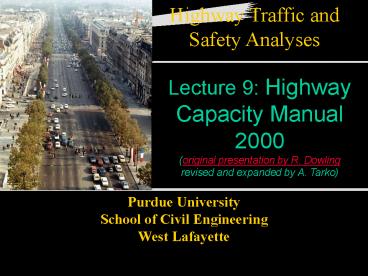Highway Capacity Manual 2000 - PowerPoint PPT Presentation
1 / 22
Title:
Highway Capacity Manual 2000
Description:
Exhibit 9-1 lists facility types and components. ... See Chapter 9 discussion on precision. See end of Part III Chapter for sensitivity discussion ... – PowerPoint PPT presentation
Number of Views:72
Avg rating:3.0/5.0
Title: Highway Capacity Manual 2000
1
Highway Traffic and Safety Analyses
Lecture 9 Highway Capacity Manual 2000 (original
presentation by R. Dowling revised and expanded
by A. Tarko)
Purdue University School of Civil
Engineering West Lafayette
2
Lecture Objectives
- To highlight the content of the Year 2000 edition
of the Highway Capacity Manual. - To help identify suitable procedures in the
Manual things and properly apply to traffic
operations problems.
3
Purpose of the HCM
- To provide transportation practitioners and
researchers with a consistent system of
techniques for the evaluation of the quality of
service on highway and street facilities. - HCM does not set policies regarding a desirable
or appropriate quality of service
4
HCM 2000 Formats
- Book
- Five parts, 35 chapters
- CD-ROM
- Book
- Audio-visual tutorials
- CD-ROM presentation
5
HCM 2000 Table of Contents
- Part I - Overview
- Part II - Concepts
- Part III - Methodologies
- Part IV - Corridor and Areawide Analyses
- Part V - Simulation and Other Models
6
Part II. Concepts
- Describes factors affecting LOS.
- Identifies required input.
- Suggests default values for input.
- Provides service volume tables
7
HCM Components
8
(No Transcript)
9
HCM Components and Structure
- Chapter 9 is Your Gateway to the HCM
- Exhibit 9-1 lists facility types and components.
- The same exhibit gives Part II and Part III
chapter references for each facility type. - Chapter 9 Provides Guidance on
- Use of defaults.
- Use of or development of service volume tables.
- Precision and accuracy of results.
10
Chapter 9 Structure of HCM
11
Chapter 9 Structure of HCM
12
Part III. Methodologies
- Provides Methodologies to Compute
- Level of Service, Delay, Queues
- Contents
- Freeway Facilities (4 chapters)
- Urban Streets (3 chapters)
- Highways (2 chapters)
- Pedestrian Bikeways (1 chapter)
- Transit (1 chapter)
13
Intersection Control
14
Required Data for Signals
15
Level of Service Criteria
16
Level of Service Criteria
17
Transit LOS Criteria
18
Part IV. Corridor/Areawide
- Purpose
- How to adapt HCM to planning models
- Multi-Modal Corridor Analysis
- Computation of intensity, duration, extent of
congestion (for performance measures) - Areawide Analysis
- Capacity analysis for planning models
- Speed-flow and node delay equations for models
19
Part V. Simulation
- Purpose
- Guidance on the use of simulation for conditions
beyond the bounds of Part III. - Contents
- Chapter 31. Simulation and Other Models
- Introduction to simulation techniques
20
Using the HCM 2000
- Determine Facility Type
- See Exhibit 9-1, Chapter 5 Definitions
- Exhibit 29-2 provides summary.
- Review Concepts, Inputs, Defaults
- Review relevant Part II chapter.
- Conduct Analysis
- Apply relevant Part III chapter.
- Interpretation of Results
- See Chapter 9 discussion on precision.
- See end of Part III Chapter for sensitivity
discussion
21
CD ROM Tutorials
- 4. Delay 335
- 9. Control Delay at Signalized
- Intersections 550
- 20. Bicycle Events and Hindrance 305
- 21. Bicycle LOS by Facility Types 410
- 32. Transit Quality of Service 505
22
Highway Capacity Software
- No official TRB approved software
- FHWA sponsored software (2)
- Windows (Catalina),
- EZ-HCS written in JAVA
- Other developers
- McTrans, Strong Concepts, Dowling, KLD, etc.































